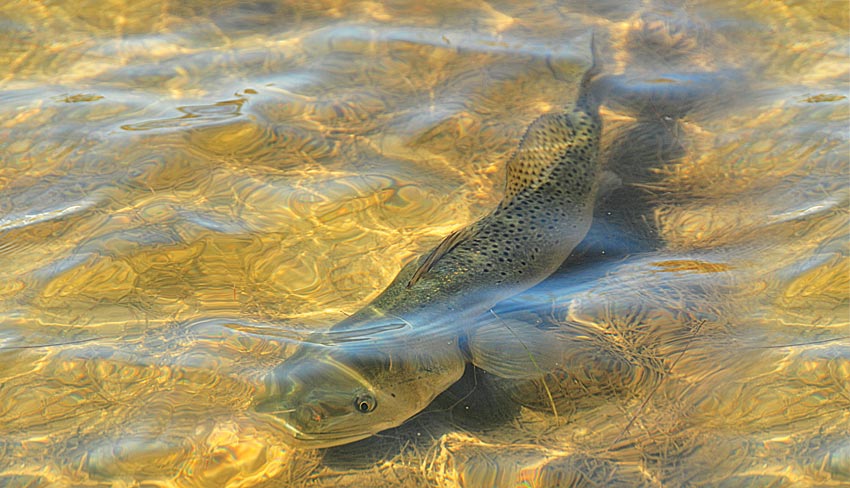
Spotting Fish
A great deal of saltwater fly-fishing takes place in shallow water and, in many circumstances, requires anglers to see a fish prior to casting. For some, this skill comes naturally, and for others — well, it’s something that must be learned.
Just ask any fly guide out there what the two biggest obstacles are that he encounters daily, and he will tell you: individuals who cannot cast and those who cannot see fish, or worse, both. I’m going to shed some light on how you can be more successful at spotting fish, thus bettering your game.
Scanning the Surface
One of the biggest mistakes anglers make is putting on their sunglasses way too early in the day. The whole purpose of polarized glasses is to take the glare off the water so you can see into it. This optical innovation actually hinders anglers in low-light conditions who are hoping to find tails waving above the surface.
In the early morning light, the glare on the water helps silhouette the darker tails as they protrude skyward. In addition, the polarization that so effectively takes the glare off the water also takes the glare off of wet, shiny fish tails. Many times, when the sun catches a tail just right, it will send a flash that can be seen for quite some distance. This is especially helpful when higher water levels cover more of the fish than you’d like or when clouds move in, preventing the light from penetrating to the bay bottom. Consider this the next time you are standing on the bow and your guide points out tailing fish that you cannot find. Whether the light is low or not, just pull your glasses down, and you might be surprised by what you see.
Another tip: When looking for tailing fish, work toward the sun, especially when it’s close to the horizon. The sunlight shining through a fish’s tail will light it up like a beacon. This method also helps prevent your shadow or the shadow of your fly line from spooking fish in the early morning hours.
Seeing into the Water
Conversely, when you’re looking for subsurface fish, I cannot emphasize enough the need to have a quality pair of polarized sunglasses. Of course, there are many schools of thought on what is the right color lens to have for different conditions. A good rule of thumb is that gray lenses enhance contrast, while colored lenses enhance color. In my experience, this is about as true as can be, and there is only one situation in which I will pull out a pair of gray-lens glasses: when I’m looking for shadows of fish over an all-white-sand bottom. Otherwise, I use copper- or vermillion-colored glasses. Lighter amber-colored lenses can work quite well on overcast days. The copper-hued lenses make grass flats (where a great deal of flats fishing is done) come alive with color. From the powdery blue tails of redfish to the pinkish fork on a tarpon’s tail in off-colored water, everything is enhanced.
Once you’re satisfied with a pair of glasses and lenses, it’s time to start looking for fish. But don’t look too hard. This can cause tunnel vision and ultimately increase the odds of your missing something. Let your eyes relax and scan the water, or more precisely, the bottom. The biggest piece of advice I can give you is to learn to focus your eyes not on the surface but rather on the bottom. If you get into the habit of staring at a ripple on the surface, you will never learn to see fish.
While scanning for cruising or laid-up fish, you should be looking for several things: movement, shapes, color and contrast. I cannot stress enough the importance of knowing the fish you are chasing. The trick is, once you identify something moving or a different color or contrast, start trying to find one of the other pieces of the puzzle until a fish appears or you determine that whatever you are looking at is not a fish.
For example, you are poling a grass flat and see a pothole 80 feet away, and while studying it, you notice something move. At this point, you should start looking for a shape, color or even shadow on the bottom to help you identify what the movement is. Hopefully, after a few short moments, a grayish torpedo shape will appear hovering in the hole, and all you’ll have do is decide which end it eats from.
Another technique is to keep your eyes fixed on anything of interest. Keep looking at the object until you identify it, even if it’s not a fish. After you have done this over and over, you can refer to a mental library of images that will help you more quickly discount those things that are not the fish we all love to catch.
Look Before You Leap
When you first start sight-fishing, your first step should be to keep your eyes peeled for everything. When you do catch a glimpse of a fish, pay attention to what you see. Try to tattoo that image in your brain so you know what to look for the next time. The vision of an angler is somewhat like a muscle, and practicing is how your eyes become “dialed in.” The more you sight-fish, the stronger it gets. Maybe at first you will be able to see a coloration or a shape that you know is a fish. But until your eyes are trained a bit, you may not be able to determine what species it is or, more importantly, which end of the shape or coloration is the head and which end is the tail. You’ll be surprised at how much better your vision will become after a little practice. It’s not so much that your eyesight improves but that, after time, your eyes simply know what to look for.









